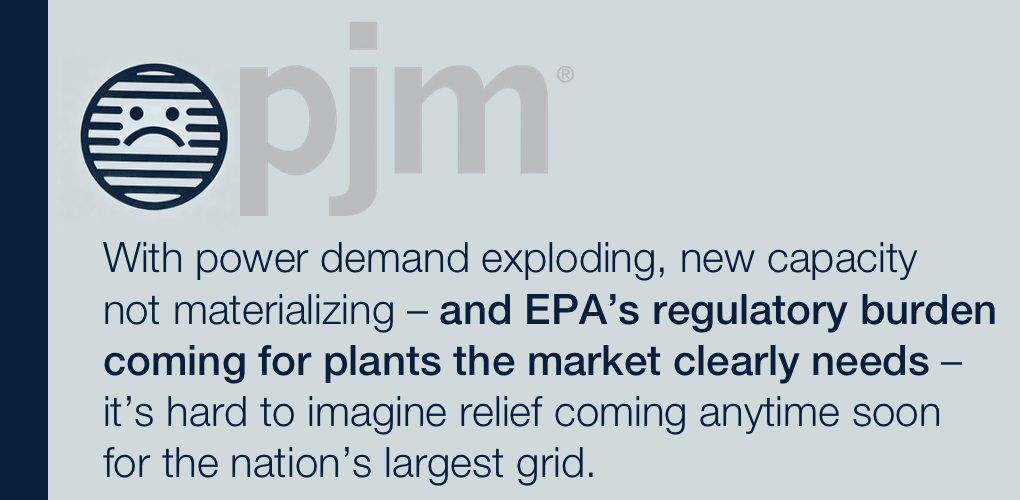
PJM Can’t Get New Capacity Online
At the precise moment power demand is exploding, PJM, the operator of the nation’s largest grid, is struggling to get new capacity online. In fact, the problem is doubly difficult. At the exact time PJM desperately needs new capacity additions to surge, they’re stalled, and the U.S. Environmental Protection Agency (EPA) is making matters worse with its relentless drive to take essential dispatchable capacity offline.
Just 2,000 megawatts (MW) of capacity, nearly all of it solar, has come online in PJM this year, down from close to 5,000 MW in 2023. And because solar can’t be counted on during peak demand conditions – like a bitterly cold night – that 2,000 MWs of nameplate capacity is in fact an addition of far less, “which is nowhere near where we need to be,” said Paul McGlynn, PJM vice president of planning.
Project developers are facing a variety of challenges outside of PJM’s control, including long-lead times to procure equipment, growing local opposition to industrial-scale renewable projects and financing obstacles.
According to PJM, nearly 450 projects totaling about 37.2 GW in nameplate capacity have signed interconnection agreements but haven’t been built.
While renewable advocates have again and again pointed to the interconnection queue as the critical chokepoint in holding back projects, PJM is adamant that just the opposite is true. The grid operator has reformed its process, is clearing significant capacity yet it isn’t being built while reserve margins continue to tighten and capacity prices in the grid footprint soar.
In PJM’s latest capacity auction, payments to generators, a sort of insurance premium to assure plants are available when needed, jumped 800%. PJM estimates that these higher capacity prices will add an estimated $14.7 billion to customer rate payments.
With new capacity not materializing – and EPA’s regulatory burden coming for plants the market clearly needs – it’s hard to imagine relief coming anytime soon. In fact, with demand soaring from electrification and the rapid addition of hyperscale data centers in the PJM footprint, a bad situation could very well get much worse.
A National Crisis
PJM expects power demand to jump 40% in the next 15 years while it’s also going to lose its core of dispatchable, fuel-secure generating capacity. Thanks largely to EPA’s regulatory agenda, PJM’s Independent Market Monitor has warned the grid is likely to lose an alarming 58 gigawatts of capacity by 2030, almost all of it traditional dispatchable capacity. Once boasting the largest reserve margin of any independent market, PJM now expects to be short of capacity by 2030.
The challenges and projected capacity shortfalls facing PJM are hardly unique. This isn’t a regional problem. It’s a national crisis.
MISO, the grid operator for much of the Midwest, has issued a troublingly similar warning. In June, MISO said that if its members don’t delay retirements of power plants or bring more resources online faster and at larger numbers than they have historically, a potential 2.7-gigawatt deficit next year could soar to 14 GW in 2029. A deficit of that size is equivalent to being short the power needed for 10 million homes.
Like PJM, interconnection is no longer the key challenge. MISO has 50 GW of new generating capacity, mostly intermittent renewables, across 316 projects that have been approved for connection but are experiencing delays in construction.
MISO and PJM have made it abundantly clear the challenges and shortfalls they’re facing aren’t theoretical. They’re here. Our next president is facing an electricity crisis, and the key first step in addressing it is pumping the breaks on EPA’s unworkable agenda.
Federal Energy Regulatory Commissioner Mark Christie summed up the danger of this moment in a scathing tweet: “As I have said for past 3 years, the rapid premature retirements of dispatchable resources without comparable new capacity is leading to a reliability crisis, not only in PJM but nationally.” He added, “Reality will track you down and it is.”
- On October 2, 2024
